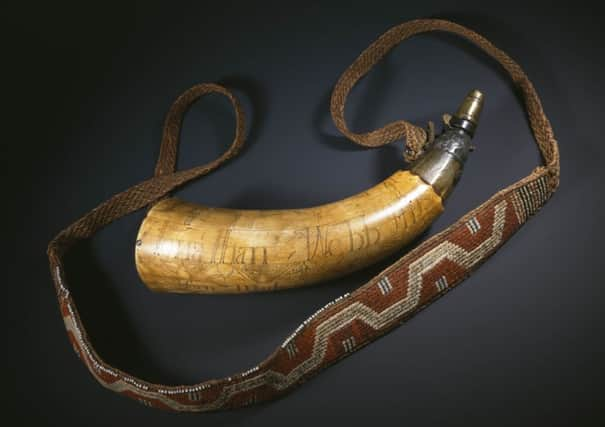Black Watch alliances in Seven Years War revealed


This summer a group of historians, anthropologists and First Nation community members assembled at the Woodlands Cultural Centre in Brantford, Ontario. They met to share knowledge and discuss research into the civilisations and arts of the Great Lakes region. Part of their discussion revolved around an object from the collections of National Museums Scotland, an elaborately engraved powder horn made around 1758 during the Seven Years War (1756-1763) also known in North America as the French and Indian War.
The object is fascinating as it reveals not only information about the military history of the period but also the context in which it came into being, during a time of war amid shifting Native American, First Nation, and European allegiances. The powder horn is one of the pieces being investigated as part of a new research initiative investigating ethnographic collections in military museums. We have developed a programme of workshops and pilot studies, bringing together anthropologists and military historians, to appraise existing collections, archives and photographs and to re-assess how these collections function in their military context.
Advertisement
Hide AdAdvertisement
Hide AdThe engraved powder horn is inscribed with two names: one Jonathan Webb, possibly an amateur American engraver, and the other James Cameron, a Scottish soldier of the British Army serving with the 42nd Highlanders, the Black Watch, along the Saint Lawrence River Valley. His regiment was part of a substantial British presence whose objective, aided by their Native American, First Nation and colonial allies, was to counter the influence of France.
To contend with the woodland terrain, the 42nd and other British infantry regiments formed “light” companies. A horn for extra gunpowder and a bag of extra shot was issued to each man so they could make their own cartridges as they engaged in skirmishing. A foreshortened Iroquois burden strap is attached to the powder horn. It is made of woven and plaited nettle fibre with “false embroidery” of dyed moosehair in the central portion, which is also delicately edged with white glass beads, to create colourful and dazzling geometric patterns. Burden straps were multipurpose items, to be used for carrying, adopted by British forces. From the orderly books held by the Black Watch we know that in 1759 the light company of the 42nd was issued with burden straps, or “tumplines”, bought locally to tie up their blanket rolls. While there are many surviving mid-eighteenth century powder horns, few bare traces of Iroquois material culture. This is a rare instance of a burden strap is attached to a powder horn.
As a cross-cultural object born of a military alliance, the powder horn challenges some of the more obvious assumptions which might be made about military collecting. Material brought back to this country from service overseas includes the proceeds of looting and souvenir hunting. But this is not the whole story. There are also instances of co-operation, diplomatic exchange and collecting informed by those with archaeological, anthropological and scientific interests. In order to understand the full range of encounters and relationships which are represented by military collections, we have embarked on two pilot studies in collaboration with the National Army Museum in London.
One of the studies, funded by the Royal Society of Edinburgh, brings together colleagues from anthropology and military history. This forum has allowed us to think about the status and identity of particular collections, and the significance of the widespread practice of modifying such objects to embed them in regimental and corps history. Our discussions have highlighted the complex relationship between this material and similar collections held by larger museums to which they are often linked but where they have been recorded and understood in an entirely different way.
The second study, funded by the British Academy and Leverhulme Trust, has permitted us to survey collections relating to the Seven Years War in North America and the Younghusband Mission (expedition) to Tibet of 1904. This will enable us to compare the products of two very different British military campaigns in the light of specialist knowledge. We are building a collaborative research initiative which seeks to increase knowledge, understanding and appreciation of the value and meaning of non-European material in military collections.
To properly appreciate these military collections and the encounters they represent, we believe we must achieve a balance in interpretation. This must take into account the complex contexts of acquisition, their historic importance to the cultural identities of the regiments and corps themselves, and their current significance to the communities of source who came into contact and conflict with the military forces of the British empire.
• Dr Henrietta Lidchi is Keeper of World Cultures and Dr Stuart Allan is Principal Curator of Scottish History and Archaeology at National Museums Scotland (www.nms.ac.uk)
SEE ALSO